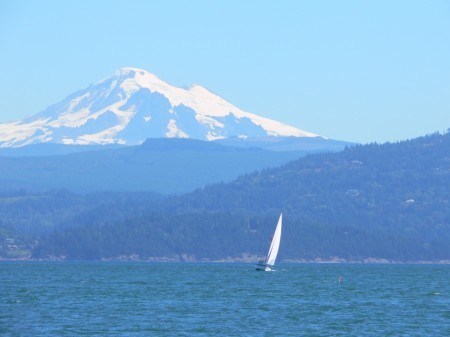
By Gail Lynne Goodwin.
A very wise man once said, “The only thing we have to fear is fear itself”. Sometimes we must take the risk, live the adventure and confront things that might frighten us.

Yesterday my husband and I arrived at San Juan Sailing, the premier charter company in the San Juan Islands off the coast of Seattle, Washington, to pick up a yacht for a two-week sail. Her name is Hula Kai, and she’s a beautiful 42′ Catalina sailboat.
We are both avid sailors with more than 20 years of experience, mainly in the Caribbean. Knowing that we’re dealing with different things in the Pacific Northwest, we needed to be educated.
Prior to taking her out for our adventure, we sat through a very thorough boat briefing with 15 other captains and crews that had also chartered bare boats (no captains) for the week. Our introduction began with a safety briefing.
The instructor provided us with a detailed description of many of the hazards and things that could go wrong on the voyage. “There will be floating logs, some horizontal and some vertical, almost hidden- and if you hit them you could sink. There will be eel grass and floating meadows of sea kelp that could foul the propeller, rendering the engine useless. If you fall overboard into the 50-degree waters you will die of hypothermia, usually within 15 minutes. There will be rocks throughout the area that are hidden just under the surface of the water. If you hit them, it could sink your boat. The tides fluctuate up to 12’ four times a day and in some areas, the currents are strong enough to make passage impossible if you’re going against it at the wrong time of the day. If a bank of fog rolls in, you should stay put and wait it out, as you don’t know what you could hit. There are major freight shipping lanes going in/out of Seattle and Vancouver, so be careful of the container ships when crossing the channel. Also, if you get too close to the orca whales, you may be fined up to $35,000!”
One woman shared out loud that she was ready to just go home to Michigan and not even board the boat. The instructor went on to say that historically, 90% of the problems encountered, happened to experienced, returning sailors, not the novices- so just pay attention and be careful.
I have to admit, when we left the dock I was wondering if, with all these things to worry about, I’d enjoy this cruise or not. I’ve sailed all over the Caribbean and I’m not afraid to go anywhere in those islands. I convinced myself that this was no different- it was just a new experience where I was unfamiliar with the area- just as I had once been in the Caribbean.
I know that the things we fear are always worse than reality. So, we prepared ourselves the best we could by planning where we’re going in advance, making certain we knew the best route to get there, and paying attention to where the nasty rocks and hazards were hidden. Then, we threw off the bowlines and set sail on our two-week adventure.
We spent the day cautiously navigating our way around islands, including some areas where the treacherous rocks are located. The map made it look ominous, especially with the red markings, but when we got to that point in the sound where the rocks were located, it wasn’t as bad as I thought it would be. Perhaps because we were prepared, or most likely, because my mind made it out to be much worse than it was. The fear of the hazards was much worse than the hazards themselves. It was a good reminder to me that when we plan in advance and are diligent, there is little to be afraid of.
How many times in life do we not do things we want to do, because of the fear of “what if”? What if I hit a log? What if I hit a rock or a reef? What if the weather turns, the fog rolls in and I can’t get back? What if…? We would have missed some of the most beautiful sailing in the world had we listened to the “what if’s” in our mind, rather than filling our sails with the wind and heading to new shores.
No matter where we are, no matter what we want to do… we will always have our own versions of floating logs, rocks and hazards in life. But in life, as in sailing, ships weren’t built to live in harbors, but rather, to sail and explore the wide-open adventure called life.
Likewise, I think Mark Twain said it best, “Twenty years from now you will be more disappointed by the things that you didn’t do than by the ones you did do. So throw off the bowlines. Sail away from the safe harbor. Catch the trade winds in your sails. Explore. Dream. Discover.”

This Post Has 0 Comments